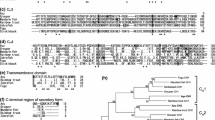Abstract
A new immunoglobulin heavy-chain gene with some homology to mammalian IgD was recently cloned from the channel catfish and Atlantic salmon, two species of teleost fish. We have cloned and sequenced a new H-chain gene from Atlantic cod (Gadus morhua L.) which has clear similarities to these genes, but which also differs in several ways. The similarities of catfish, salmon, and cod delta to the mammalian delta genes are sequence homology, location immediately downstream of IgM (mu), and expression by alternative splicing rather than class switching. A unique feature of catfish, salmon, and cod delta is the chimeric nature of the gene product, as the μ1 exon is spliced to the δ1 exon. Several unique features of cod IgD were found: (1) a deletion of the δ3, δ4, δ5, and δ6 domains described in catfish and salmon IgD, (2) a tandem duplication of a part of the delta locus including the δ1 and δ2 domains, (3) the presence of a truncated δ7 domain downstream of the δTM exons, and (4) the separation of the duplicated domains by a short exon (δy) which has homology to a conserved part of the transmembrane exon 1 (TM1) of some H-chain isotypes. This unique organization of the delta locus of cod probably developed after the evolutionary split from the catfish and salmon branches.
Similar content being viewed by others
Author information
Authors and Affiliations
Additional information
Received: 18 August 1999 / Revised: 28 December 1999
Rights and permissions
About this article
Cite this article
Stenvik, J., Jørgensen, T. Immunoglobulin D (IgD) of Atlantic cod has a unique structure. Immunogenetics 51, 452–461 (2000). https://doi.org/10.1007/s002510050644
Issue Date:
DOI: https://doi.org/10.1007/s002510050644




